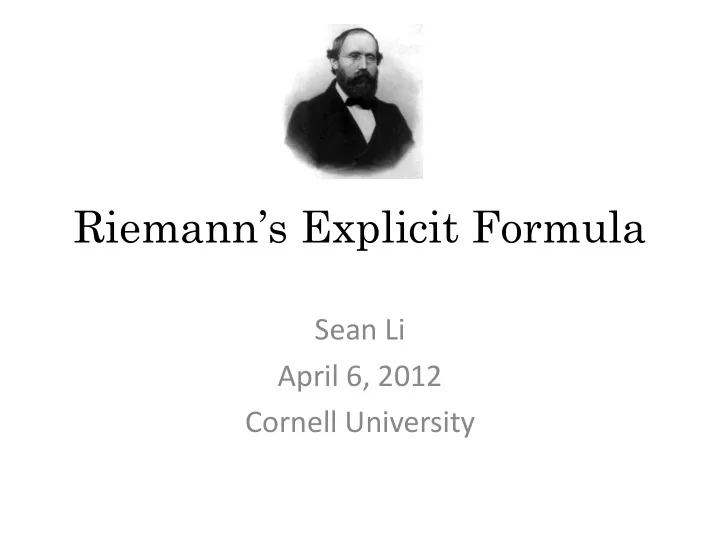

Riemann’s Explicit Formula Sean Li April 6, 2012 Cornell University
Goal Our goal is to understand the interesting equation where
Outline 1. Motivation 2. Background 3. Derivation of Riemann’s Explicit Formula 4. Connection Between Riemann’s Formula and the Prime Number Theorem 5. Computations
Prime Number Theorem Gauss observed in 1792(???), while he was studying logarithm tables, that the density of the prime numbers near x is about 1/log x . This led him to conjecture the Prime Number Theorem: Proved in 1896 independently by Jacques Hadamard and Charles Jean de la Vallée-Poussin, using complex analysis.
Prime Number Theorem But how good is the Prime Number Theorem approximation?
Prime Number Counts 𝒚 𝒚 𝒆𝒖 𝒚 𝝆(𝒚) log 𝒚 log 𝒖 𝟏 10 4 4.3 6.2 100 25 21.7 30.1 1,000 168 144.8 177.6 10,000 1,229 1,085.7 1,246.1 100,000 9,592 8,685.9 9,629.8 1,000,000 78,498 72,382.4 78,627.5 10,000,000 664,579 620,420.7 664,918.4 x 𝒆𝒖 The integral is called the logarithmic integral, Li( x ) 𝟏 log 𝒖 How far off is this approximation?
Is There an Exact Formula for 𝜌(𝑦) ?
Is There an Exact Formula for 𝜌(𝑦) ? Yes. Riemann found an explicit formula in 1859 in his paper “On the Number of Primes Less Than a Given Magnitude.” The formula, which is the main result of the paper, was derived largely by (very accurate) intuition.
Background Recall that (Proof: Expand the right-hand side as a series and multiply out all the terms.) This is the definition of 𝜂(𝑡) for Re( s ) > 1.
Analytic Continuation Zeta can be analytically continued to the half-plane Re(s) > 0 by cancelling the pole at s = 1. (This was shown in class.)
Analytic Continuation Zeta can be analytically continued to the half-plane Re(s) > 0 by cancelling the pole at s = 1. (This was shown in class.) But zeta can be extended further.
Functional Equation We will use Riemann’s definition of 𝜊(𝑡) , which has the advantage that it has no poles. The pole of zeta at s = 1 is cancelled by (𝑡 − 1) . • The poles of Γ 𝑡/2 + 1 are cancelled by the trivial zeros of the zeta • function, at s = -2, -4, -6, etc. Thus 𝜊 𝑡 is an entire function with zeros precisely at the nontrivial zeros of the zeta function. It satisfies the symmetric relation
Functional Equation Riemann assumed (in 1859) that it is possible to factor an entire function in terms of its roots, obtaining the following expression for 𝜊 𝑡 : The factorization theorem was not proved until 1893, by Hadamard.
Functional Equation Riemann combined the previous two results to obtain
J( x ) Define J(x) as a step function as follows: • J(0) = 0 • J jumps by 1 on each prime number. • J jumps by ½ on each prime square. • … J jumps by 1/n on each prime power 𝑞 𝑜 •
J( x ) We want an equation connecting J(x) and 𝜂(𝑡) .
Start with the Euler product formula. Take the log of both sides. From elementary calculus, Substituting, we have
This converges absolutely, so we can interchange the sums and integral, being careful with the indices:
Riemann then applies the inverse Laplace transform (closely related to the inverse Fourier transform):
Riemann then applies the inverse Laplace transform (closely related to the inverse Fourier transform): And then substitutes
Then a miracle occurs…*
And he obtains *This was not fully proved until 1895 by von Mangoldt. Note: The second term must be summed in order of increasing imaginary part as it converges conditionally.
Counting Primes Riemann now forms 𝜌(𝑦) in terms of J(x). The first step is Then he applies a Möbius inversion to obtain
Explicit Formula Thus he found an exact formula for the prime counting function. where
Explicit Formula Thus he found an exact formula for the prime counting function. where Main Term Oscillatory Term Log 2 Term Integral Term
Main Term Oscillatory Term Log 2 Term Integral Term Question How fast does the oscillatory term grow?
The Oscillatory Term A deep result assumed by Riemann and proved by von Mangoldt was that actually converges. But let us see what this term means.
Group the zeros with their conjugate roots so the sum becomes We use the asymptotic relation to obtain when the roots are written as .
This simplifies to Note that , so Then
This simplifies to Note that , so Then If the Riemann Hypothesis is true, then this sum grows like . If there are no zeros in a region , then the sum obeys for .
Computation Suppose we wanted to compute 𝜌(10) .
Computation Suppose we wanted to compute 𝜌(10) .
Computation Suppose we wanted to compute 𝜌(10) . 𝑵𝒃𝒋𝒐 Oscillatory* Log 2 Integral Total 𝐾(10) 6.1656 -.1415 -.6931 .0018 5.3328 − 1 1 -1.1539 -.1757 .3466 -.0172 -1.0002 2 𝐾 10 2 − 1 1 -0.4189 -.1091 .2310 -.0364 -.3334 3 𝐾 10 3 Total 4.5928 -.4263 -.1155 -.0518 3.9992 *5000 iterations of the term in Mathematica 8
Prime Number Counts 𝒚 𝒚 𝝆(𝒚) 𝑴𝒋(𝒚) Explicit* log 𝒚 10 4 4.3 6.2 4.0 100 25 21.7 30.1 24.9 1,000 168 144.8 177.6 168.0 10,000 1,229 1,085.7 1,246.1 1,229.0 100,000 9,592 8,685.9 9,629.8 9,592.0 1,000,000 78,498 72,382.4 78,627.5 78,498.9 10,000,000 664,579 620,420.7 664,918.4 664,580.9 *After the first row, I ignored the log 2 and integral terms in the calculations, as well as all the oscillatory terms after n = 5.
References Derbyshire, John. Prime Obsession . Joseph Henry Press, 2003. Edwards, H. M. Riemann’s Zeta Function . Academic Press, 1974. Ingham, A. E. The Distribution of Prime Numbers . Cambridge University Press, 1934. Stein, Elias M. and Rami Shakarchi. Complex Analysis . Princeton University Press, 2003. Stopple, Jeffrey. A Primer of Analytic Number Theory . Cambridge University Press, 2003.
Recommend
More recommend